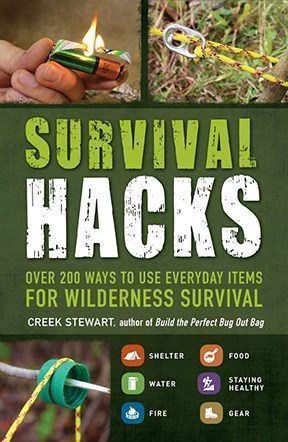
Survival Hacks: 200 Ways To Use Everyday Items for Wilderness Survival
By Devinne Zadravec
If you are an outdoors fanatic, chances are you have occasionally pondered how you would survive an emergency situation on one of your adventures. If you are a serious explorer, chances are you already have a handful of survival tricks and tips up your sleeve. Bestselling author and outdoorsman Creek Stewart takes those tips one step further in his new guidebook Survival Hacks, demonstrating over 200 creative and practical uses for household items to help you survive in the wilderness.
This book covers everything from easy DIY shelters and gear hacks to navigation and survival tricks. A great read for the imaginative explorer, check out below some of our favorite hacks from this great read!
Excerpt from Survival Hacks: Gum Wrapper Fire
A foil-backed gum wrapper (or any foil-backed paper candy wrapper) can be used to start a fire if you have a battery source such as a AA battery from a flashlight or remote control. Start by trimming the wrapper to an hourglass shape. Touch the positive and negative terminals of the battery with the foil side of the wrapper simultaneously. The electrical current will converge on the part of the hourglass shape and ignite the wrapper to flame. If the battery is too weak to bring the foil to flame, consider adding a second battery for more electrical current. Be sure to have a good tinder bundle ready because you’ll only have about 3 seconds of flame!
Spider Web Net
In certain times of the year (typically spring and fall) the forest is filled with dew-soaked spider webs in the mornings. This is the perfect opportunity to make a spider web fishing net. Cut a 48″ flexible green branch from any live tree. It should be less than 1/4″ in diameter. After trimming the leaves and branches, bend the top down to form an oval net frame. Tie it in place with a small piece of twine or bark cordage. Next, walk through the forest and sweep 20-30 spider webs onto the frame.
As you sweep them up, you will see the net grow stronger and stronger. Once it is strong enough to catch a small pebble it is ready to sweep through shallow pools and along the banks of ponds and streams to catch bait minnows and tadpoles. These can be used to catch larger fish for cooking.
Duct Tape Snow Goggles

Snow blindness (photokeratitis) is a very real phenomenon. Imagine sunburn-like symptoms except they occur on your cornea. It’s not only painful but it can literally blind you until it heals several days later.
Hacking an Inuit -inspired pair of snow goggles is the best solution. First, tear off 2 6″ strips of duck tape and stick them together, sticky side in. Then cut 2 slits where the eyes will be. Lastly, attach a head strap by poking holes on each end of the duck tape goggles.
The slit reduces the eye’s exposure to sunlight and thus helps prevent a burn on the eyeballs. Dark fabric, leather, and bark can also be used instead of duct tape.
Finger Clock
This hack isn’t so much about finding direction as it is knowing when to stop hiking and start making base camp for the night. Many survivors underestimate how long it can take to set up a proper base camp, and then find themselves rushing around in low-light conditions. A reliable way of estimating the amount of time left until sunset is by using your fingers.
Hold your hand up sideways with the bottom of the sun resting on top of your index finger. Now, count the number of fingers going down until they connect with land. Each finger represents approximately 15 minutes of sunset available.
Drink with a Bandana
Many people completely overlook one of the best sources of water in a survival scenario–dew. The dew that collects on grass, rocks, and leaves is 100 percent safe to drink without purification. The trick is collecting it. I’ve experimented with many ways and have found the best collection method is to mop it up with a bandana or t-shirt and wring it out every few mops into a container. I have collected more than 2 gallons of water in under 1 hour using this method in a small meadow near Willow Haven (my survival training facility).
Grasses are not poisonous so there is no general risk with mopping dew from meadows, fields, or transition areas that lead into forests. If you’re wearing clothing, then you have a means of collecting dew.
Creek Stewart is an expert survival instructor and survival hacks author of the best-selling Build the Perfect Bug Out series of books. Stewart is also the Weather Channel Survival Expert, as well as the host of the show Fat Guys in the Woods. He is also the owner and founder of Willow Haven Outdoor Survival Training Schools in central Indiana.
- The Catskills: Hidden Gems of Upstate New York - July 11, 2017
- Rockport, Massachusetts, Famous Seaport Village - July 14, 2016
- Biking the Globe: Around the World in 6 Years - May 3, 2016







